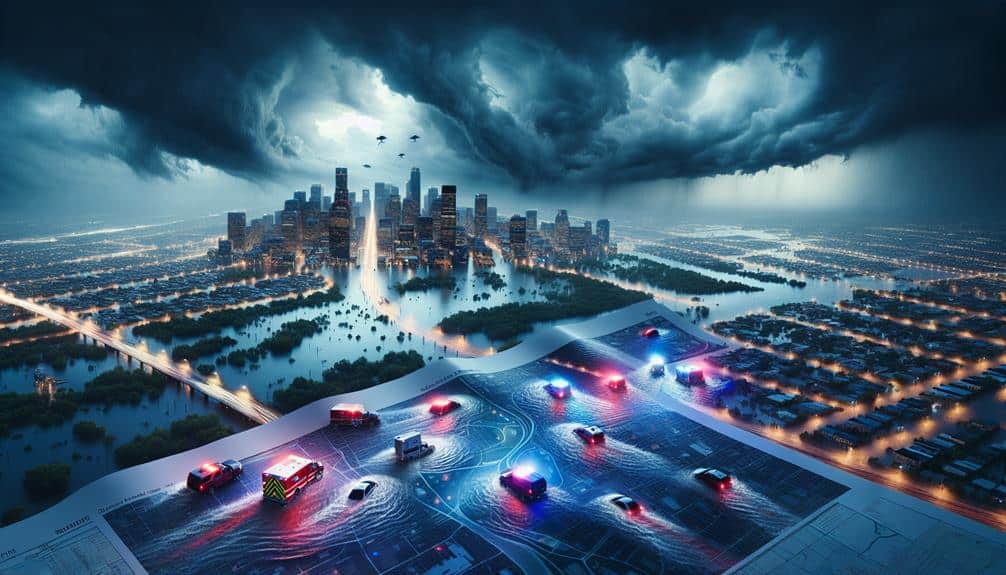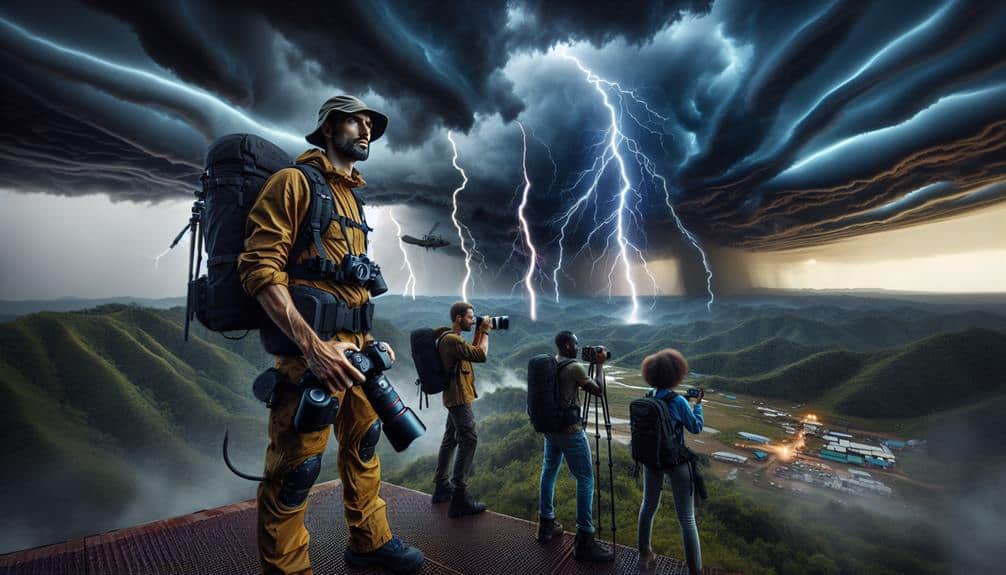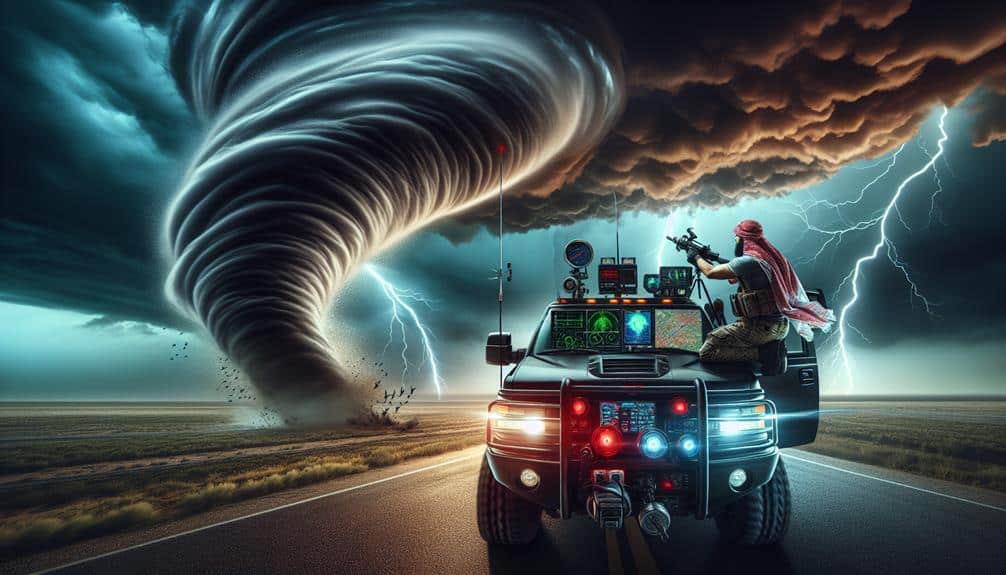When storm chasing in urban areas, we must thoroughly assess unique hazards due to high population density and complex infrastructure. Identifying risks like traffic congestion, structural vulnerabilities, and electrical hazards is essential. We should evaluate buildings' construction materials, design standards, and maintenance records to assess their structural integrity. Analyzing crowd dynamics helps us predict human behavior and evacuation routes under severe weather conditions. Establishing robust communication channels and emergency response plans, including predefined evacuation routes and shelter points, enhances our operational efficiency and safety. Our continued evaluation and planning can deepen our understanding of these urban-specific challenges.
Key Points
- Evaluate structural integrity of buildings to anticipate potential collapse or debris hazards.
- Monitor real-time weather updates and use mobile apps for immediate storm tracking and alerts.
- Plan and familiarize yourself with multiple evacuation routes to avoid congested or blocked paths.
- Always be aware of electrical hazards like downed power lines and electrified puddles.
Identifying Urban Hazards
Frequently, when evaluating urban storm chasing risks, we must accurately identify potential hazards such as flooding, wind damage, and infrastructure failure. By focusing on traffic dangers and building risks, we can better anticipate the challenges we might face.
Urban environments amplify these risks due to higher population density and complex infrastructure. Traffic dangers include the potential for accidents on congested roads, which can escalate during a storm due to reduced visibility and wet conditions.
Building risks are another critical factor. High winds can cause structural damage, leading to falling debris and compromised safety zones. We must be aware of the potential for electrical hazards, such as downed power lines, which can electrify puddles and metal objects, posing serious risks.
Additionally, storm debris, from broken glass to tree branches, can become projectiles, further complicating navigation and increasing the chances of injury.
Understanding these hazards allows us to take proactive measures. We can plan routes avoiding high-traffic areas and secure locations with minimal building risks. By remaining vigilant about electrical hazards and debris concerns, we can enhance our safety and maintain the freedom to chase storms effectively.
Evaluating Structural Integrity
Evaluating the structural integrity of buildings in urban areas requires a thorough analysis of construction materials, design standards, and maintenance records to predict their resilience against severe weather conditions.
We must start by examining the structural stability of key components like load-bearing walls, roofing systems, and foundation materials. Using data from recent inspections, we can assess if these elements meet current building codes and identify any deviations.
Next, we focus on the design standards employed during the construction phase. Modern buildings often adhere to strict codes that account for wind loads, seismic activity, and other environmental stresses. By comparing these standards with those of older structures, we can gauge the relative resilience of different buildings in the urban landscape.
Maintenance records are equally vital. Buildings that undergo regular inspections and repairs tend to exhibit higher structural stability. We should look for documentation on past renovations, especially those addressing critical areas like the roof and foundation.
Assessing Crowd Dynamics
Understanding crowd dynamics in urban storm chasing scenarios requires a thorough analysis of human behavior patterns, population density, and movement flow during severe weather events. We need to predict how people will react under such conditions to implement effective crowd control and safety measures. High population density in urban areas necessitates precise modeling of behavioral patterns to anticipate areas of congestion and potential hazards.
When evaluating crowd dynamics, we analyze historical data and real-time information to map out likely evacuation routes. Identifying choke points and high-risk zones allows us to advise authorities on best crowd control strategies. For example, understanding typical human responses—like the tendency to flock towards known exits—enables us to suggest alternative pathways to alleviate pressure on primary evacuation routes.
Utilizing simulations, we can test various scenarios to enhance our predictive models. These simulations help us determine the impact of different safety measures, like barriers or rerouted traffic, on crowd flow. By continuously updating our models with new data, we maintain a high level of accuracy in our evaluations.
This rigorous approach ensures that we can provide actionable insights to improve safety and facilitate freedom of movement during storm events.
Communication and Coordination
Effective communication and coordination are essential for guaranteeing timely and accurate dissemination of information during urban storm chasing events. By establishing robust communication channels, we can ensure real-time sharing of critical weather updates and safety protocols, minimizing risks to our team and the public.
First, we must integrate advanced technologies like GPS tracking and real-time data feeds. This approach guarantees that everyone on our team is continuously informed about shifting weather patterns. We should employ mobile apps that provide instant weather updates, allowing us to adapt our strategies based on the latest data.
Next, employing a hierarchical communication structure helps streamline decision-making processes. Assigning specific roles ensures that each team member knows their responsibilities, enhancing our operational efficiency. For instance, one member may focus on monitoring weather updates while another coordinates with emergency services.
Moreover, conducting regular drills and simulations can prepare us for actual storm chasing scenarios. These exercises help us internalize safety protocols, making our responses more instinctive and efficient during high-pressure situations.
Emergency Response Planning

Building on our robust communication and coordination strategies, we now focus on developing a comprehensive emergency response plan that guarantees prompt and efficient action during urban storm chasing events.
An essential component involves defining precise evacuation routes. We'll map out multiple pathways to make sure we can quickly relocate to safer areas, avoiding congested or flood-prone zones. These routes need continuous updates based on real-time data and changing storm trajectories.
Next, adhering to strict safety protocols is paramount. We'll implement standard operating procedures (SOPs) for every member of our team, covering scenarios from severe weather alerts to direct storm impact. These protocols enhance our readiness and minimize risks.
Identifying shelter locations in advance is another critical step. We'll pinpoint and verify buildings that can withstand high winds and flooding, ensuring they're accessible along our predetermined evacuation routes. Coordination with local authorities to confirm the viability of these shelters will further strengthen our preparedness.
Frequently Asked Questions
What Equipment Is Essential for Urban Storm Chasing?
Just like explorers venturing into uncharted territories, we need safety gear and reliable communication devices for urban storm chasing. Helmets, sturdy boots, and two-way radios guarantee we stay safe and connected in unpredictable conditions.
How Can I Stay Updated on Real-Time Weather Conditions?
We can stay updated on real-time weather conditions by using weather apps for radar updates and emergency alerts. Additionally, social media platforms provide immediate information and user-generated data to help us navigate urban storm situations efficiently.
What Are the Best Practices for Documenting Storm Chasing Experiences?
To document storm chasing experiences effectively, we should prioritize safety measures and meticulous data collection. Using high-resolution cameras, GPS logging, and real-time weather apps guarantees accurate records while keeping us aware of evolving weather conditions and hazards.
How Do I Prepare My Vehicle for Urban Storm Chasing?
Let's guarantee our chariot is in tip-top shape. Prioritize vehicle maintenance by checking brakes, tires, and fluid levels. Implement safety precautions like securing emergency kits and communication devices. It's our duty to chase storms with precision and freedom.
What Are Some Legal Considerations When Storm Chasing in Urban Areas?
When storm chasing in urban areas, we've got to verify our liability insurance is up-to-date, secure necessary permits, respect privacy laws, and understand property rights to avoid legal issues and maintain our freedom to safely pursue our passion.


